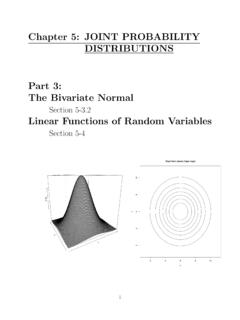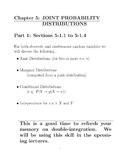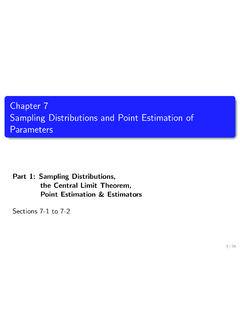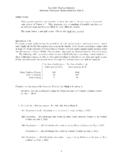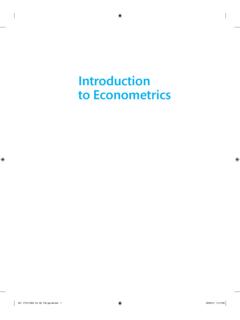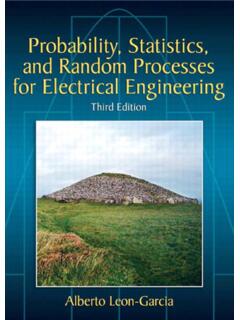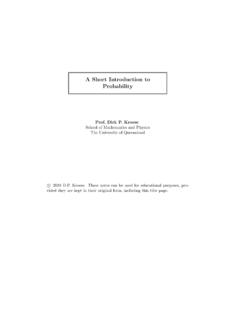Transcription of Chapter 5: JOINT PROBABILITY DISTRIBUTIONS Part 1 ...
1 Chapter 5: JOINT PROBABILITYDISTRIBUTIONSPart 1: Sections to bothdiscreteandcontinuousrandom variables wewill discuss the JOINT DISTRIBUTIONS (for two or s) Marginal DISTRIBUTIONS (computed from a JOINT distribution ) Conditional DISTRIBUTIONS ( (Y=y|X=x)) Independence sXandYThis is a good time to refresh yourmemory on double-integration. Wewill be using this skill in the upcom-ing a discreteprobability distribution (orpmf) for a Xwith the example (x) we re simultaneously interested intwo or more variables in a random re looking for a relationshipbetween the for s Year in college vs. Number of credits taken Number of cigarettes smoked per day vs. Dayof the weekExamples for s Time when bus driver picks you up of caffeine in bus driver s system Dosage of a drug (ml) vs. Blood compoundmeasure (percentage)2In general, ifXandYare two random variables,the PROBABILITY distribution that defines their si-multaneous behavior is called a JOINT here as a table for two discrete randomvariables, which givesP(X=x,Y=y).
2 X12310 1/6 1/6y21/6 0 1/631/6 1/6 0 Shown here as a graphic for two continuous ran-dom variables asfX,Y(x,y).3 IfXandYare discrete, this distribution can bedescribed with a JOINT PROBABILITY mass continuous, this distribution canbe described with a JOINT PROBABILITY density function. Example: Plastic covers for CDs(Discrete JOINT pmf)Measurements for the length and width of arectangular plastic covers for CDs are roundedto the nearestmm(so they are discrete).LetXdenote the length andYdenote the possible values ofXare 129, 130, and131mm. The possible values ofYare 15 and16mm(Thus, bothXandYare discrete).4 There are 6 possible pairs (X,Y).We show the PROBABILITY for each pair in thefollowing table:x=length129 130 131y= sum of all the probabilities is combination with the highest probabil-ity is (130,15).The combination with the lowest probabilityis (131,16).
3 The JOINT PROBABILITY mass functionis the func-tionfXY(x,y) =P(X=x,Y=y). Forexample, we havefXY(129,15) = we are given a JOINT PROBABILITY distributionforXandY, we can obtain the individual prob-ability distribution forXor forY(and theseare called theMarginal PROBABILITY Dis-tributions).. Example: Continuing plastic covers for CDsFind the PROBABILITY that a CD cover haslength of 129mm( 129).x= length129130 131y= (X= 129) =P(X= 129 andY= 15)+P(X= 129 andY= 16)= + = is the PROBABILITY distribution ofX?6x= length129130131y= PROBABILITY distribution forXappearsin the column (x) NOTE: We ve used a subscriptXin the probabilitymass function ofX, orfX(x), for clarification sincewe re considering more than one variable at a can do the same for theYrandom variable:rowx= lengthtotals129130131y= (y) the the PROBABILITY mass functions forXandYappear in the marginsof the table( column and row totals), they are often re-ferred to as theMarginal there are two random variables of inter-est, we also use the termbivariate probabil-ity distributionorbivariate distributionto refer to the JOINT JOINT PROBABILITY Mass FunctionThe JOINT PROBABILITY mass functionof the dis-crete random variablesXandY, denoted asfXY(x,y), satisfies(1)fXY(x,y) 0(2) x yfXY(x,y) = 1(3)fXY(x,y) =P(X=x,Y=y)For when the s are discrete.
4 (Often shown with a 2-way table.)x= length129 130 131y= Marginal PROBABILITY Mass FunctionIfXandYare discrete random variableswith JOINT PROBABILITY mass functionfXY(x,y),then the marginal PROBABILITY mass functionsofXandYarefX(x) = yfXY(x,y)andfY(y) = xfXY(x,y)where the sum forfX(x) is over all points inthe range of (X,Y) for whichX=xand thesum forfY(y) is over all points in the rangeof (X,Y) for whichY= found the marginal distribution forXin theCD example (x) : When asked forE(X) orV(X) ( val-ues related to only 1 of the 2 variables) but youare given a JOINT PROBABILITY distribution , firstcalculate the marginal distributionfX(x) andwork it as we did before for the univariate case( for a single random variable). Example: BatteriesSuppose that 2 batteries are randomly cho-sen without replacement from the followinggroup of 12 batteries:3 new4 used (working)5 defectiveLetXdenote the number of new the number of used ) FindfXY(x,y){ the JOINT PROBABILITY distribution }.
5 B) FindE(X).ANS:a) ThoughXcan take on values 0, 1, and 2,andYcan take on values 0, 1, and 2, whenwe consider them jointly,X+Y 2. So,not all combinations of (X,Y) are are 6 possible : no new, no used (so all defective)fXY(0,0) =(52)(122)= 10/6612 CASE: no new, 1 usedfXY(0,1) =(41)(51)(122)= 20/66 CASE: no new, 2 usedfXY(0,2) =(42)(122)= 6/66 CASE: 1 new, no usedfXY(1,0) =(31)(51)(122)= 15/6613 CASE: 2 new, no usedfXY(2,0) =(32)(122)= 3/66 CASE: 1 new, 1 usedfXY(1,1) =(31)(41)(122)= 12/66 The JOINT distribution number ofnewchosen012y=number of010/6615/66 3/66used120/6612/66chosen26/66 There are 6 possible (X,Y) , x yfXY(x,y) = ) FindE(X).15 JOINT PROBABILITY Density FunctionA JOINT PROBABILITY density functionfor thecontinuous random variableXandY, de-noted asfXY(x,y), satisfies the (x,y) 0 for all x, y2. fXY(x,y)dx dy= 13. For any regionRof 2-D spaceP((X,Y) R) = RfXY(x,y)dx dyFor when the s are Example: Movement of a particleAn article describes a model for the move-ment of a particle.
6 Assume that a particlemoves within the regionAbounded by thexaxis, the linex= 1, and the liney=x. Let(X,Y) denote the position of the particle ata given time. The JOINT density ofXandYis given byfXY(x,y) = 8xyfor(x,y) Aa) Graphically show the region in theXYplane wherefXY(x,y) is PROBABILITY density functionfXY(x,y)is shown graphically the information thatfXY(x,y) = 0for (x,y) outside ofA, we could plot the fullsurface, but the particle is only found in thegiven triangleA, so the JOINT PROBABILITY den-sity function is shown on the gives a volume under the surface that isabove the regionAequal to (x,y)xyf(x,y)Not apdfApdf18b) FindP( < X <1,0< Y < )c) FindP(0< X < ,0< Y < )19d) FindP( < X <1, < Y <1)20 Marginal PROBABILITY DensityFunctionIfXandYare continuous random variableswith JOINT PROBABILITY density functionfXY(x,y),then the marginal density functionsforXandYarefX(x) = yfXY(x,y)dyandfY(y) = xfXY(x,y)dxwhere the first integral is over all points inthe range of (X,Y)
7 For whichX=x, andthe second integral is over all points in therange of (X,Y) for whichY= :E(X) andV(X) can be obtained byfirst calculating the marginal PROBABILITY distri-bution ofX, orfX(x).21 Example: Movement of a particleAn article describes a model for the move-ment of a particle. Assume that a particlemoves within the regionAbounded by thexaxis, the linex= 1, and the liney=x. Let(X,Y) denote the position of the particle ata given time. The JOINT density ofXandYis given byfXY(x,y) = 8xyfor(x,y) Aa) FindE(X)22 Conditional PROBABILITY DistributionsRecall for eventsAandB,P(A|B) =P(A B)P(B)We now apply this conditioning to random random variablesXandYwith jointprobabilityfXY(x,y), the conditionalprobability distributionofYgivenX=xisfY|x(y) =fXY(x,y)fX(x)forfX(x)> conditionalprobability can be statedas thejointprobability over : we can definefX|y(x) in a similar manner if we areinterested in that conditional Example: Continuing the plastic ) Find the PROBABILITY that a CD cover hasa length of 130mmGIVEN the width :P(X= 130|Y= 15) =P(X=130,Y=15)P(Y=15)= ) Find the conditional distribution ofXgivenY= (X= 129|Y= 15) = = (X= 130|Y= 15) = = (X= 131|Y= 15) = = you re GIVEN thatY=15, you re in a different space.
8 For the subset of the covers with a width of15mm, how are the lengths (X) conditional distribution ofXgivenY=15,orfX|Y=15(x):x129 130 131fX|Y=15(x) sum of these probabilities is 1, and thisis a legitimate PROBABILITY distribution . NOTE: Again, we use the subscriptX|Yfor clarityto denote that this is a conditional conditional PROBABILITY distributionfY|x(y)has the following properties are satisfied: For discrete random variables (X,Y)(1)fY|x(y) 0(2) yfY|x(y) = 1(3)fY|x(y) =P(Y=y|X=x) For continuous random variables (X,Y) |x(y) 02. fY|x(y)dy= (Y B|X=x) = BfY|x(y)dyfor any setBin the range ofY26 Conditional Mean and Variancefor DISCRETE random variablesThe conditional meanofYgivenX=x, de-noted asE(Y|x) or Y|xisE(Y|x) = yyfY|X(y) = Y|xand the conditional varianceofYgivenX=x, denoted asV(Y|x) or 2Y|xisV(Y|x) = y(y Y|x)2fY|X(y)= yy2fY|X(y) 2Y|x=E(Y2|x) [E(Y|x)]2= 2Y|x27 Example: Continuing the plastic 130 131y= ) Find theE(Y|X= 129) andV(Y|X= 129).
9 ANS:We need the conditional distribution |X=129(y)2829 Conditional Mean and Variancefor CONTINUOUS random variablesThe conditional meanofYgivenX=x,denoted asE(Y|x) or Y|x, isE(Y|x) = yfY|x(y)dyand the conditional varianceofYgivenX=x, denoted asV(Y|x) or 2Y|x, isV(Y|x) = (y Y|x)2fY|x(y)dy= y2fY|x(y)dy 2Y|x30 Example 1: Conditional distributionSuppose (X,Y) has a PROBABILITY density (x,y) =x+yfor 0< x <1,0< y <1a) FindfY|x(y).b) Show fY|x(y)dy= )32b)One ) What is the conditional mean ofYgivenX= :First getfY|X= (y)fY|x(y) =x+yx+ 0< x <1 and 0< y <1fY|X= (y) = + + +yfor0< y <1E(Y|X= ) = 10y( +y)dy=71233 IndependenceAs we saw earlier, sometimes, knowledge of oneevent does not give us any information on theprobability of another , we stated that ifAandBwere in-dependent, thenP(A|B) =P(A).In the framework of PROBABILITY DISTRIBUTIONS ,ifXandYare independent random variables,thenfY|X(y) =fY(y).
10 34 IndependenceFor random variablesXandY, if any of thefollowing properties is true, the others arealso true, andXandYare independent.(1)fXY(x,y) =fX(x)fY(y)for all x and y(2)fY|x(y) =fY(y)for all x and y withfX(x)>0(3)fX|y(x) =fX(x)for all x and y withfY(y)>0(4)P(X A,Y B) =P(X A) P(Y B)for any setsAandBin the range of X and how (1) leads to (2):fY|x(y) =fXY(x,y)fX(x)=fX(x)fY(y)fX(x)=fY(y)35 Example 1: (discrete)Continuing the battery exampleTwo batteries were chosen without the number of new the number of used number ofnewchosen012y=number010/6615/663/66of used120/6612/66chosen26/66a) Without doing any calculations, can youtell whetherXandYare independent?36 Example 2: (discrete)Independent random variablesConsider the random variablesXandY,which both can take on values of 0 and ) AreXandYindependent?y01fY|X=0(y)37y01fY| X=1(y)DoesfY|x(y) =fY(y) for all x & y?
